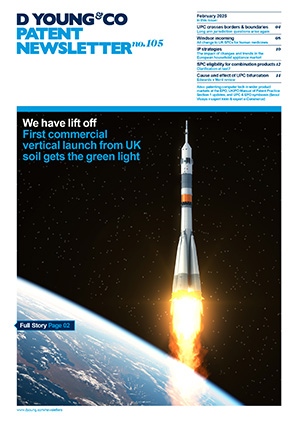Data-driven innovation: IP protection for techbio platforms
Here we assess the forms of protection available for platform innovation within the techbio field, which may differ from the forms of protection available for innovation arising from using techbio solutions within the biotech and life sciences fields.
IP protection for data-driven innovation in the life sciences field
Techbio is fast emerging as a technical sector of interest, focusing on the application of “big data” techniques to drive innovation in the biotech and life sciences fields. Data-driven analysis can reduce the amount of wet lab experimental research needed to identify relevant biological pathways and screen candidate compounds for the treatment of particular diseases. As discussed in our article about the rise of techbio and its intellectual property (IP) needs, patent protection can, in principle, be available for compounds or methods of treatment arrived at using computational methods, with the claims of the patents covering the compounds or methods of treatment themselves (rather than the methods used to develop them) in the same way as those obtained through traditional wet lab methods.
Related article
The rise of techbio and its IP needs: IP strategies for data-driven innovation, 06 April 2023.
Read moreTechbio innovation may also lie in the provision of a machine learning based diagnostic tool, for example, a machine learning model trained to predict, based on biomarker data or scan images from a patient, whether a patient has a particular medical condition. Patent protection can be available for such diagnostic tools. However, the patent application should be drafted carefully to ensure commercial relevance of the claims, and to ensure that the specification provides a sufficient disclosure of the machine learning model and how it was trained, in order to permit arguments for the presence of an inventive step to be made during prosecution. Care must also be taken when drafting the patent application to avoid restrictions on the patentability of diagnostic methods, which exist in many jurisdictions. Our article about practical considerations for patenting AI provides more detailed tips on drafting patent applications in the field of machine learning.
What intellectual property is available for techbio platform providers?
Some life science and biotechnology companies may wish to use computational approaches to further their research, but may not have the expertise to develop their own data-driven research tools. Therefore, an emerging class of techbio companies, which develop generic computation platforms that can be licensed for use by others and applied to a wide range of life science problems, are coming to the fore. For example, the platform may provide a generic machine learning framework, and users of the tool may provide their own data sets for training this tool to handle a specific task. Developers of such a techbio platform may wish to protect their investment using IP. What options are available?
Protection using unregistered rights (for example, copyright and trade secrets)
Copyright will automatically subsist in the software underpinning the platform and can be useful in supporting licensing of the software to customers, but will only protect the specific code and not the underlying functions. Care should be taken in agreeing terms on ownership of the copyright when engaging contractors for software development work. Confidential know-how associated with the working of the techbio platform may also be protected as a trade secret. However, such unregistered forms of IP will not protect against a competitor independently producing a competing platform without any copying of your innovation.
Patent protection
In view of the limitations of unregistered rights, patents may provide stronger protection of the technical functionality of the techbio platform. Patents can provide a monopoly right which can be enforced against others even if there is no evidence of copying. However, for generic platform providers, it can be challenging to obtain strong patent protection, as most patent offices have restrictions on the patentability of abstract mathematical methods defined generically without a specific real world use case, and overcoming these restrictions may require the patent to be relatively narrow in scope.
For example, in Europe patentability requires a claimed invention to provide a technical contribution. As with other types of mathematical methods, the European Patent Office (EPO) considers claims to machine learning based methods to be excluded from patentability unless either:
- The claim specifies a specific technical purpose for which the method is used (for example, application of the computational platform to development of a treatment for a particular disease); or
- The claim defines a specific technical implementation of the method, and the method is particularly adapted for that implementation, in that its design is motivated by technical considerations of the internal functioning of the computer (for example, this could apply if the machine learning model includes processing steps adapted for particularly efficient use of memory or network bandwidth).
For a generic platform provider the use case may be defined by the customer, not inherent to the platform itself, and so it may be a challenge to define a specific technical purpose, which could meet the EPO’s requirements, while still being generic enough to cover all likely uses. If a patent is to be granted, it may be that the patentee needs to accept a compromise where the patent is limited to a particular use or class of uses (for example, prediction of a compound for treatment of a specific class of medical conditions), rather than being defined for generic application. For an inventive step to be present, it may also be that the claim needs to be limited to specific features of the computational processing adapted for the claimed use that make the processing work better for that use.
A claim directed to a specific technical implementation might be relatively narrow in scope, and it may be that others producing similar competing techbio tools might not adopt the same technical implementation, or it might be difficult to check whether a competitor’s platform uses that technical implementation. Nevertheless, if there are any inventive features which make the platform use hardware resources of a computer more efficiently, this could provide a route to patentability that might not be limited to a particular use.
Another factor to consider when considering patent protection for data driven techbio platforms is that patent applications are generally published 18 months after the first filing. To meet the requirement of sufficient disclosure of the invention, most patent offices expect to see detailed disclosures of implementation methods for a machine learning platform, so the publication of the patent application may give away information to others which might have been hard to reverse engineer from the product itself. Companies may wish to balance this against the chances of success of obtaining adequate patent protection, when considering whether to file a patent application.
However, one strategy can be to file a patent application initially to allow for any non-confidential discussions of the technology with potential investors or commercial partners, and to then decide in good time before the 18-month publication date whether to allow the application to publish, and continue efforts to prosecute the patent to grant, or withdraw the patent application to prevent publication of its contents. This decision could be based on the patent office search opinion, which will often be received in the first 12 months after filing, and/or based on any feedback from investors or commercial partners.
Therefore, there can be a complex set of considerations to take into account when assessing what steps to take, which will vary depending on the specific technology at issue. With close collaboration from attorneys in D Young & Co’s life sciences and computing groups, our team can review your specific needs and help you decide how to proceed.
Related webinar
Protecting innovation in the techbio sector, presented by Robbie Berryman, Jennifer O’Farrell and Alan Boyd.
Read more

